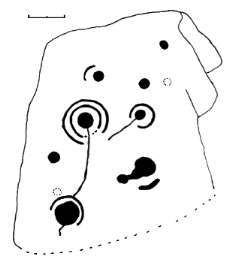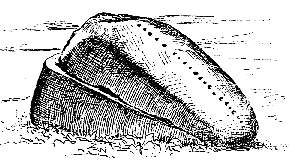Yorkshire Rock Art
Part 2 - The Lemmington wood rune stone.
Part 3 - Cupmarks in churchyards & Greystones.
Part 4 -Extracts from the journals of the Society of Antiquaries of Scotland (text only).
Part 5 - The Giants Lapstone.
Back to main index
In Britain there are several cup and ring marked stones that have specific names and associated folklore which indicate their use in historic times and might possibly be an echo of their prehistoric use.
Enquiries are being pursued to trace the origins of the name, which may connect the carved rock with some kind of folklore practices in the area.

 The TREE OF LIFE STONE - This is the name given
to a large flat rock with cup marks and connecting channels, one
of a group of carvings at the edge of moorland and situated on
rough grazing land overlooking the Washburn valley north of
Otley, North Yorkshire.
The TREE OF LIFE STONE - This is the name given
to a large flat rock with cup marks and connecting channels, one
of a group of carvings at the edge of moorland and situated on
rough grazing land overlooking the Washburn valley north of
Otley, North Yorkshire.
E.T. Cowling in his book "Rombalds Way" (1946)
describing the Tree of life stone, records that ......
"it is one of the few known to local
inhabitants, and marks the site of many May day religious
services." What form these "religious services"
took, is not recorded but the site is a strange one for any
Christian Ceremony, being on a remote hillside, in an area
populated mostly by hill farmers. So even if the service was a
christian one this is perhaps an indication that it was
introduced to replace a popular and more "traditional"
mayday activity at the site which the local clergy did not
approve of.
In the past, Mayday folklore and customs related specifically to
promoting fertility in people, animals and the land, with trees,
maypoles and foliage playing an integral part in these customs.
The tree like arrangement of cups and channels on the Tree of
Life stone may have made it a suitable focus for such customs and
in the process led to the naming of the stone.
(Interestingly the Washburn valley is also
known for the activities of a group of women who were accused of
being witches in the 1600's.)
 The WITCH'S STONE - This was the name given to
a now destroyed cup marked boulder on Tormain Hill near the
village of Ratho (7miles west of Edinburgh) The sloping upper
surface of the rock had a line of 24 cup marks and this surface
had also become highly polished due to the practice of people
sliding down the stone. A similar practice took place a few miles
away in the kings Park, Edinburgh, which was the site of a large recumbent stone along which barren women slid in the hope that it
would help them to conceive a child. Whether this was the reason
for sliding down the Witch's stone is not recorded but this
activity and the stones name suggests this possibility, as before
their persecution the town and village wise women (later deemed
witches) were the keepers of traditional lore relating to
fertility and bareness.
The WITCH'S STONE - This was the name given to
a now destroyed cup marked boulder on Tormain Hill near the
village of Ratho (7miles west of Edinburgh) The sloping upper
surface of the rock had a line of 24 cup marks and this surface
had also become highly polished due to the practice of people
sliding down the stone. A similar practice took place a few miles
away in the kings Park, Edinburgh, which was the site of a large recumbent stone along which barren women slid in the hope that it
would help them to conceive a child. Whether this was the reason
for sliding down the Witch's stone is not recorded but this
activity and the stones name suggests this possibility, as before
their persecution the town and village wise women (later deemed
witches) were the keepers of traditional lore relating to
fertility and bareness.
Murthly Farm, Aberfeldy. Perthshire (PSAS vol18 p112 + Vol16 p98) - On the hillside near this farm there are several cup an ring marked boulders. One the top of one large boulder there are nine cup marks, and one cup and ring mark, below which, on the sloping side of the stone there is a smooth slide, ".....highly polished by persons sliding down it for amusement, as is also the case at the Witch's stone, near Ratho."
The AULD WIVES LIFTS - Craigmaddie muir
PSAS 1905 1906.p299 - This is the name given to an unusual rock formation consisting of an enormous sandstone block poised
on top of two other blocks of similar size. A narrow passage
exists between the two supporting blocks, while directly over the
passage there is a large circle (1m dia) cut into the rock
surface of the upper block. Tradition says the stones were
dropped by witches or carlines and that crawling through the passage between the rocks would prevent infertility.
(A cup marked stone is also noted 300yds south of the Auld wives
lifts.)
The BALVARRAN CUP MARKED STONE Kirk michael Perthshire PSAS 1920-21 p95 - A large cup marked boulder in a field near Balvarran mansion house has the tradition that the heirs to the family were christened at the stone and that a new cup mark was added on each successive occasion. When the tradition was broken and a child was baptised at the house instead, this resulted in there being no more male heirs and the family line came to an end in 1807.
The WITCHCRAFT STONE - Clach na Buidseach - Strathtay perthshire PSAS 1920-21 p38 - This is the name given to a large cup marked boulder built into a dry stone wall on Tullypowrie farm. No tradition was noted regarding how the stone came by this name, although Local opinion was that the stone was a cresset to hold lamps for monks attending midnight services.
"FAIRIES FOOTMARKS" - Glenelg Inverness-shire PSAS 1881-2 p120 -A large cup marked slab lay in a field near Castle Troddan. The local farmer remarked that as a child he would walk barefoot on the stone dipping his toes in the cupmarks for amusement, he added that the cupmarks were known locally as Fairies Footmarks.
"ST COLUMBA'S FONT" - Killianian
grave yard, near Abraichan PSAS Vol 16 p 377. - This is the
name given to a block of stone with a cavity cut into it.
Tradition holds that St columba used the stone for baptism when
he visited the area.
The stone was also held to be beneficial in connection with child
birth and was still visited by women for this purpose.
The cavity was said to be always full of water and if it was
emptied out it would fill up of its own accord.
BASIN STONE near Arperfeelie, Black isle of
Taendore PSAS vol 16 p387. - On a ridge called Creag a Chree
(= rock of the trembling/rocking or cattle,) there are the
remains of several ancient hut circles (Taendore = Tigh an
Druidbh = houses of the druids) ,one of which has a basin stone
within it.
Tradition has it that in the early 1800's a local farmer took
this basin stone to his house, but as night fell his family was
greatly disturbed by strange noises, these became louder, until
on the third night the noises were disturbing the whole valley, a
thunderous voice was then heard ordering the farmer to return the
stone. The farmer returned the stone and peace returned to the
area. This basin stone was also regarded as beneficial in
connection with infertility "......when childless women
bathe in its cloud drawn waters immediately before sunrise."
CUP MARKED STONE near Arisaig, PSAS vol 16 p397 - In the ground of Arisaig House there is a large block of stone with over eighty cup marks on its upper surface. A local belief connected with the stone is that an apprentice blacksmith could gain additional skill and strength in the craft by washing his hand in the water collected in the largest cupmark/basin on the stone, this act was to be performed at sunrise on the first of May.
WELL OF THE CUPS, North Uist. PSAS vol 16 p 400. - Near the old churchyard on the Ardivoran peninsula, there is a holy well called the Well of the Cups. The spring of water flows from beneath a rock which has a cross carved on it, there are also several cup marks along the top of the rock and on other stones nearby. An old inhabitant remembered hearing that people used to make an Easter pilgrimage to the holy well, taking hard boiled pashe eggs with them to place in the cup marks around the well.
MUNE-STANE of Cargill PSAS vol 31 1896-97 p290 - This is the name given to a stone which once stood in Moon-stone Butts field in the parish of Cargill. In early accounts the stone was reported to have on it figurations of the sun, moon, and seven stars, which it has been suggested were in fact cup and ring marks. Unfortunately the stone was buried during agricultural improvements.
Still to sort..................
Cup marked stone at head of grave in Grumbeg burial place - Strathnever psas 1905-6 p 130
Cup marks on table grave stones Forcedyke churchyard psas 1905-6 p320
cup marked stone built into east wall of churchyard Arngask Gelnfarg psas 1905-6 p326
Souterain earth house has cup and ring marked stone built into pasage wall 6in square stone with thin lined concentric circles round central cup. psas 1905-6 p355
psas Vol 16 1881-2
102 cragantol =rock of the holes 100s of cup
marks on a rock
103 cup marked rock by ruined xtian cell vol 15 p82 + cupmarked
stone and basin by possible xtian enclosure killin
105 Broken cup and ringmarked stone from St peter well vol
6 p39 appdx
329 Chappin stone Clach chrotaidh =beating stone, has deep basin
for making pot barley other carvings suggest this + was font for
old chapel nearby sotne on little Urchany farm near Cawdor
inverness
+ clachmhor = great stone culnakirk farm glen urquhart big cup
marked boulder best in inverness region
335 Farm had cup marked stone over fire place
338 Farm had cup marked stone in pigsty
340 Clach thollach = holed stone 300 cup marks +1 basin on rock
near dingwall
341 pictish carving on standing stone also has cup marks -
moniack castle
347 cup marked stone in church yard
350 cup marked stone called nine holed stone + clack blane = the
white stone cup marked clach blane croft, kiltarlity
361 Crasky farm Glen Cannich cup marked slab had barn built over
and stone used as threshing floor stone amy have been part of
stone circle around a nearby mound.
362 cup marks on gravestones several examples
379 Bishops stone Near dalcross castle has rock cut cavity trad
used for baptism.
380 Priests stone clach na shagairt basin 21in dia trad used for
baptism
382 clach an tullen stone of the little hole 9in basin in sotne
used as grave marker for macdougals
383 holy water stones of st bean 2 basins 8in dia
399 cup marks on seas shore for holding shell bait
459 Crotogans ussually in threes in line sometimes a way from sea
by streams and buruak grounds
1883-84
p110 craggan-tol at the foot of Ben Lawers perthshire
p117 Knocking stones stone mortar often found with cup marks
example at site of old hamlet near killin 8i dia 6in deep used in
past for making pot barley but also had eight cup marks around basin